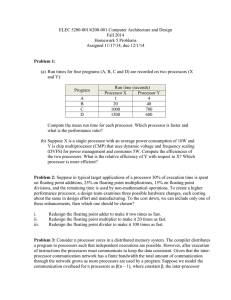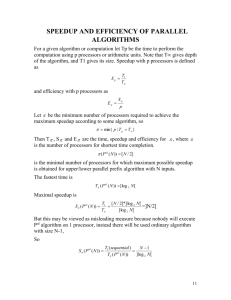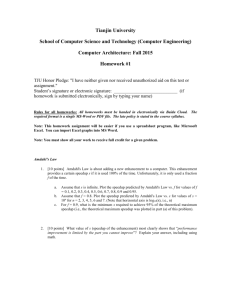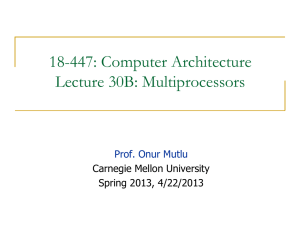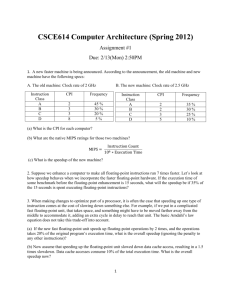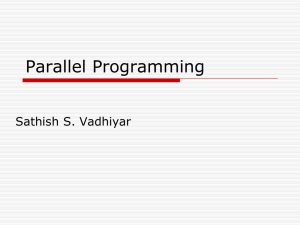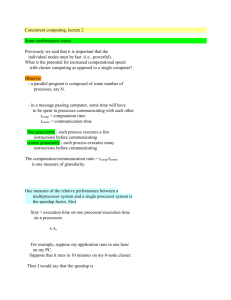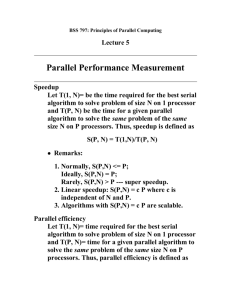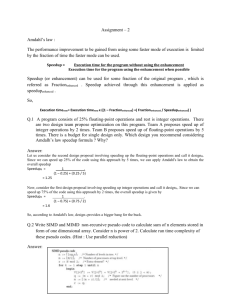Solution - Auburn University
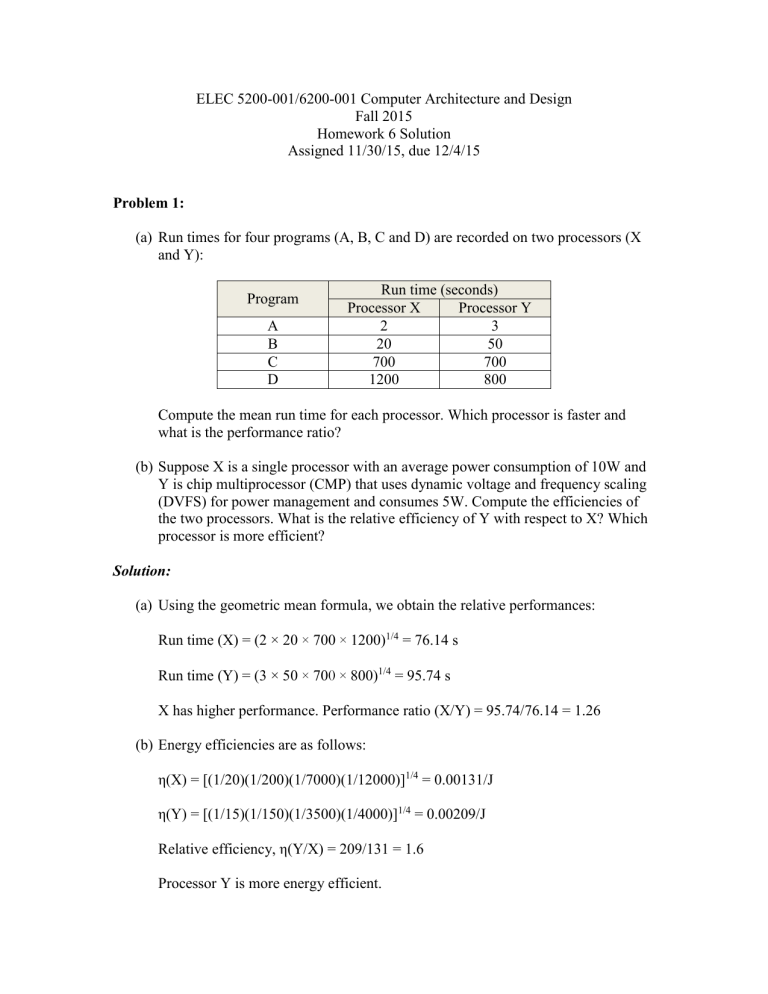
ELEC 5200-001/6200-001 Computer Architecture and Design
Fall 2015
Homework 6 Solution
Assigned 11/30/15, due 12/4/15
Problem 1:
(a) Run times for four programs (A, B, C and D) are recorded on two processors (X and Y):
Run time (seconds)
Program
A
Processor X
2
Processor Y
3
B
C
20
700
50
700
D 1200 800
Compute the mean run time for each processor. Which processor is faster and what is the performance ratio?
(b) Suppose X is a single processor with an average power consumption of 10W and
Y is chip multiprocessor (CMP) that uses dynamic voltage and frequency scaling
(DVFS) for power management and consumes 5W. Compute the efficiencies of the two processors. What is the relative efficiency of Y with respect to X? Which processor is more efficient?
Solution:
(a) Using the geometric mean formula, we obtain the relative performances:
Run time (X) = (2 × 20 × 700 × 1200) 1/4 = 76.14 s
Run time (Y) = (3 × 50 × 70 0 × 800)
1/4
= 95.74 s
X has higher performance. Performance ratio (X/Y) = 95.74/76.14 = 1.26
(b) Energy efficiencies are as follows:
η(X) = [(1/20)(1/200)(1/7000)(1/12000)] 1/4
= 0.00131/J
η(Y) = [(1/15)(1/150)(1/3500)(1/4000)] 1/4 = 0.00209/J
Relative efficiency, η(Y/X) = 209/131 = 1.6
Processor Y is more energy efficient.
Problem 2: Suppose in a typical target applications of a processor 30% of execution time is spent on floating point additions, 25% on floating point multiplications, 25% on floating point divisions, and the remaining time is used by other operations including integer math. To create a higher performance processor, a design team examines three possible hardware changes, each costing about the same in design effort and manufacturing: (i) Make floating point adder twice as fast, (ii) Make floating point multiplier 20 times as fast, (iii) Make floating point divider 100 times as fast. What will the speedup be if these design changes are incorporated? To hold the cost down, if we can include only one of the three enhancements, then which one should that be?
Solution:
Amdahl’s law states,
Speedup = 1/[(1 – f) + f/n]
Where f is the enhanced fraction and n is the speed up factor for the enhanced fraction.
For all three enhancements,
Speedup = 1/[1 – 0.3 – 0.25 – 0.25 + 0.3/2 + 0.25/20 + 0.25/100]
= 2.74
The enhanced fraction f = 0.30, 0.25 and 0.25 for addition, multiplication and division, respectively. Corresponding speed up factor n = 2, 20 and 100. Speed up ratios for the three options are: i. Speedup for adder redesign = 1/ [0.70 + 0.30/2] ii. Speedup for multiplier redesign = 1/ [0.75 + 0.25/20] iii. Speedup for divider redesign = 1/ [0.75 + 0.25/100]
The divider redesign is the best choice.
= 1.1765
= 1.3115
= 1.3289
Problem 3: Consider n processor cores in a distributed memory system. The compiler distributes a program to processors such that independent executions are possible. However, after execution of instructions the processors must communicate to keep the data consistent. Given that the interprocessor communication network has a finite bandwidth the total amount of communication through the network grows as more processors are used by a program. Suppose we model the communication overhead for n processors as β(n – 1), where constant β, the inter-processor communication overhead factor, has some small positive value. Show that the speed up can be expressed as, 1
Speedup =
(1/n) +
β
(n – 1)
(1)
Also show that:
(a) The fraction f enh of Amdahl’s law in this system equals 1 – nβ.
(b) For non-zero β, maximum speed up occurs when n = 1/√β.
(c) For a very small value of the communication overhead β > 0, the speed up, which is always less than n, attains the maximum value when it is n/2.
Solution: We assume that K instructions are equally distributed to n processors. Then,
K 1
Speedup =
=
(K/n) + K
β
(n – 1) (1/n) +
β
(n – 1)
(a) We compare (1) with Amdahl’s original formula written below:
(1)
1
Speedup = ——————
1 – f enh
+ f enh
/n
(2)
Equating the denominators of (1) and (2), we get f enh
= 1 –
β n.
(b) To find n for maximum speed up, we differentiate the denominator of (1) with respect to n and set it to 0. Thus,
– (1/n
2
) +
β
= 0, or n
2
= 1/β, or n = 1/√ β
This minimizes the denominator in (1) because the second derivative 2/n
3
is positive.
(c) Substituting the optimum number of processors in (1) and for very small
β,
1 1
Maximum speedup =
≈
= n/2, because n = √ (1/
β
)
√
β
+ √
β
–
β
2√
β
Problem 4: For an n-processor system, we define parallelizing efficiency as the ratio of actual speedup to the ideal speedup n. For the system of Problem 3 find the maximum speedups achievable with
β =
0.001 and at least 80% parallelizing efficiency.
Solution: As n increases, speedup increases but at a slower rate than n. Thus, while speedup increases with n, parallelizing efficiency drops. From the given definition of parallelizing efficiency and using equation (1) from Problem 3,
1/n 1
Parallelizing efficiency = Speedup/n =
=
≥ 0.8
(1/n) +
β
(n – 1) 1 +
β
(n – 1)n
Therefore, n(n – 1) ≤ 1/(4
β)
For
β =
0.001 we get the following result: n(n – 1) ≤ 250, n = 16, speedup = 12.9
Problem 5 (Optional): (See Lecture 11) In this problem we study the performance of the vSMP
HPCC – Virtual Symmetric Multiprocessing High Performance Compute Cluster at Auburn
University. The description of the system is available at: http://eng.auburn.edu/admin/ens/hpcc/software_programming.html
This site contains a C program pi.c that computes the value of pi using an iterative formula. The number of iterations in pi.c may be set between n = 140,000 and n = 200,000 so that the run time of a single processor is significant (~5 minutes). Note that this n is different from the number of processors in the previous problems. Here, the number of processors is ppn. Compile and run the program varying the number of processors, ppn = 1, 2, 3, 4, 5, . . . , until the performance begins to drop. Plot the run time (normalized with respect to the run time for ppn = 1) as a function of ppn. Use Matlab curve fitting program to fit equation (1) of Problem 3 and find the value of the parameter β.
Problem 6:
(a) For two instructions A and B where B follows A, define RAW, WAR and WAW dependencies? How do they influence the out-of-order issuing of B.
(b) Examine the following sequence of four instructions for out-of-order issue:
#1 R6 = R5 + R6
#2 R1 = R5 + R7
#3 R2 = R1 + R6
#4 R3 = R5 – R6
Can #2 be issued in the same cycle as #1? If not when should #2 be issued?
Can #3 be issued before #1 or #2 is retired? If not, when should #3 be issued?
Can #4 be issued either together with or before #1, 2 or 3? Explain.
Answer:
(a) RAW dependence: If a source register of instruction B is being written to by instruction A, then B has a RAW dependence on A. Thus, B must not be issued until after A is retired.
WAR dependence: If the destination register of instruction B is being read by instruction A, then B has a WAR dependence on A. Thus, B must not be issued until A is retired.
WAW dependence: If the destination register of B is being written by A, then B has a WAW dependence on A. Thus, B must not be issued until A is retired.
(b) #2 has no dependence on #1 and hence #1 and #2 can be issued together in the same cycle.
#3 has RAW dependences on both #1 and #2 and so #3 cannot be issued until after #1 and #2 are both retired.
#4 has a RAW dependence on #1 but no dependence on #2 or #3. So, #4 should be issued only after #1 is retired.
